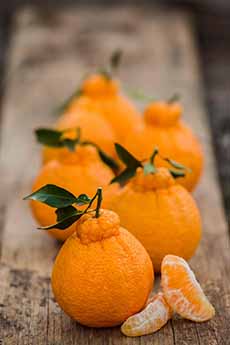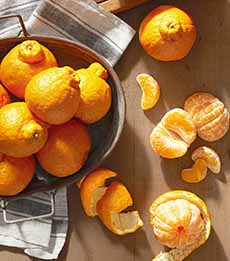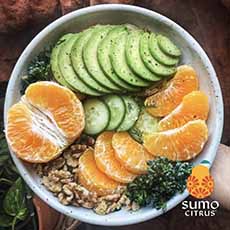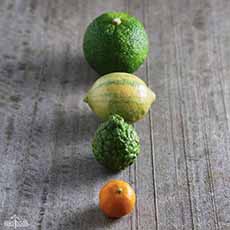TOP PICK OF THE WEEK: Sumo Citrus, A Hefty Mandarin
|
You may purchase lots of grapefruits, lemons, limes and oranges—the same ones you’ve been buying for years. But if you cast a wider net, you can find some real citrus excitement—like these Sumo Citrus® mandarins. Like Sumo wrestlers, Sumo Citrus is super-sized, and it has a topknot. It looks like a big orange, but it’s in the mandarin family (the difference between mandarins and oranges). Mandarins are easy to peel and segment, and Sumo Citrus is: Sumo Citrus was bred from the pomelo, navel orange and mandarin. In addition to size, it’s also one of the world’s sweetest mandarins. In Japan, it is known as shiranui and nicknamed the “dekopon,” a reference to its distinctive top knot. Not every dekopon is a Sumo Citrus however. It’s a brand distinction available only those fruits meeting size and taste standards. Originally, the different prefectures in Japan that grew the citrus gave them different names. However, an agreement was reached whereby any grower can use the name “dekopon” if they pay a licensing fee and meet certain quality standards. So the name “dekopon” now can refer to the fruits grown anywhere in Japan. In the U.S., something snazzier was needed to market the fruit. The brand name Sumo Citrus® was created. Think of the generic clementine mandarin, branded by different growers as Cuties and Halos, for marketing appeal. While it’s sometimes hard to tell some mandarin varieties from others, you can’t miss Sumo Citrus and its topknot. This rare seedless variety was originally cultivated in Japan in the 1970s by a grower who set out to develop “the ultimate citrus experience.” This variety was dubbed the “dekopon” [source]. In Japan, the fruits are usually grown in large greenhouses to keep them at a constant temperature, and are harvested from December to February. In the case of orchard farming, the dekopon is harvested from March to April. Harvesting trivia: After harvesting, the dekopon is usually left to sit for a period of 20–40 days so that the levels of citric acid in the fruit decrease, while the sugar levels increase. This creates a more appealing taste. Only dekopons with sugar levels above 13°Bx† and citric acid below 1.0% can be sold with the name dekopon. Sumo Citrus is only grown in the San Joaquin Valley of California, and with partner growers in Australia, all of whom have licensed the ability to grow it. Sumo seedlings were first imported into the U.S. in 1998, but because the Sumo is one of the most challenging varieties to grow, it wasn’t until 2011 that they became available to the public. The dekopon was released as a commercial product in the U.S. under the name Sumo Citrus® in early 2011. After many years, there is now enough Sumo Citrus available in the U.S. for most of us to try it—with thanks to family farms in California whose incredibly high growing standards made the crop possible. Sumo season in the U.S. is just four months: January through April. Check the store locator on SumoCitrus.com for the retailer nearest you. |
|
|
|
________________ *The citrus varieties from top to bottom: yuzu, variegated lemon, kaffir/kieffer lime, calamondin. Calamondin is a cross between a mandarin orange (Citrus reticulata, tangerine or Satsuma) and a kumquat (Fortunella margarita). †Bx, an abbreviation for brix, measures the sugar content of an agricultural product.
|
||




